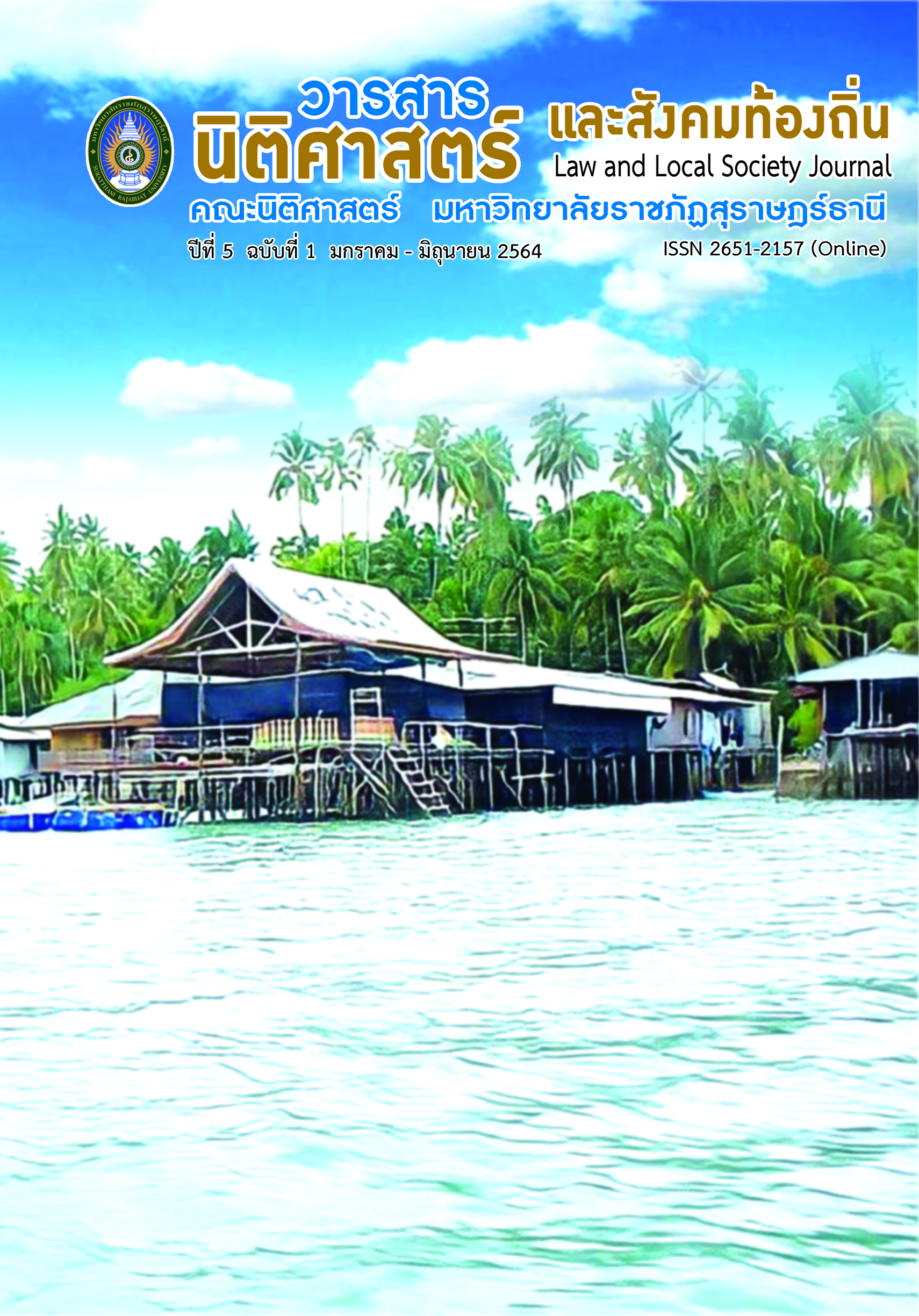จำนวนอนุญาโตตุลาการและผลต่อการทำคำชี้ขาดของอนุญาโตตุลาการ
คำสำคัญ:
arbitration, sole arbitrator, number of arbitrators, an Arbitral Awardบทคัดย่อ
Arbitration has become a popular means by which to resolve conflicts that arise from contractual agreements in a range of different commercial settings.[1] The appointment of the arbitrators is an important task for the parties, which needs to be provided in an arbitration clause. The decision on the number of arbitrators can benefit from taking account of multiple factors, including the conduct of the arbitrators; therefore, the purpose of this paper is to examine some of the factors the parties to an arbitration may consider when specifying the number of arbitrators in an arbitration clause based on a discussion of a practical case when the parties chose the number of arbitrators to settle their dispute.
This paper is expected to contribute to the general understanding of why a group of arbitrators is better than a single one when making this decision. Importantly, it seeks to identify the key factors that affect the appointment of arbitrators, including the role of arbitrators, ethics, and the way the arbitration should respond to claims of diversity in order to answer the question, “do the number of arbitrators affect the arbitration outcome?” in order to understand of the effects of arbitrator and case-specific differences on the outcomes of an arbitration.
Many domestic and International arbitration laws and rules grant to the parties their right to challenge on the number of arbitrators. The UNCITRAL Model Law, French arbitration law and Thai arbitration law will be added as the examples. Details of the meaning of the arbitration process may help to understand the concept of “arbitration”, and these are provided below.
[1] Pattawee Sookhakich, “Opportunity for Thailand to apply the “Med-Arb Process” as an Alternative Dispute Settlement Mechanism,” Assumption University Law Journal 9, No. 1 (2018): 241.
เอกสารอ้างอิง
Alaz Uzelac. “Number of arbitrators and decisions of arbitral tribunals.” Central European Public Administration review (CEPAR) 23,4 (2007): 583.
Alan Redfern and Martin Hunter, Nigel Blackaby, and Constantine Partasides.
Law and Practice of International Commercial Arbitration. London: Sweet & Maxwell, 2004.
Ashima Obhan and Akanksha Dua. “Interested Persons Cannot Appoint Sole Arbitrator.” Cooperate Law https://www.obhanandassociates.com/blog/interested-persons-cannot-appoint-solearbitrator/?utm_sour ce=Mondaq&utm_medium=syndication&utm_campaign=LinkedIn-integration (accessed January 16, 2020).
Atena, S. Feraru. “ASEAN decision-making process: before and after the ASEAN Charter,” Asian development policy review. www.Aessweb.com/download.php?id=3535 (accessed February 22, 2017).
Christopher Roberts. “International arbitration newsletter.” https://www.dlapiper.com/en/us/insights/publica tions/2012/12/parties-failureto-specify-number-of-arbitrators/ (accessed January 15, 2020).
Department of Civil Dispute Settlement and Arbitration. “Statistics of cases.”
www.dispute.ago.go.th/index.php/sn (accessed 25 April 2015).
Tony Cole. The roles of Psychology in international arbitration (Heague: Kluwer Law International. 2017).
Fabian Bonke. “Overriding an Explicit Agreement on the number of arbitra tors – one step too far under the new ICC expedited Procedure rul es?.” Kluwer Arbitration Blog, http://arbitrationblog.Kluwerarbitration.com/2017/0 5/22/overriding-an-explicitagreement-on-the-number-of-arbitrators-one-step-too-far-under-the-new-icc-expedited-procedure-rules/(accessed January 1, 2020).
Gary B. Born. International Commercial Arbitration. Wolters Kluwer Law & Business, 2014.
ICC Dispute Resolution Bulletin. ICC Dispute Resolution Statistics 2018. Paris, International Chamber of Comme rce, 2017.
Institute for the promotion of arbitration and mediation in the Mediterrane an. “Report on the criteria for selection of arbitrators.” https://www.ispramed.com/wp-content/uploads/2012/09/Report-on-Selection-of-Arbitrators.pdf (accessed January 12, 2020).
Jan Paulsson. “Moral Hazard in International Dispute Resolution.” ICSID Review – Foreign investment law journal 25, 2 (2010): 339, 352.
Koesrianti. “The development of the ASEAN trade dispute settlement mechanism: from diplomacy to legalism.” PhD thesis, University of New South Wales, 2005.
Lars Heuman and Sigvard Jarvin. “The Swedish arbitration Act of 1999, five years on: a critical review of strengths and weaknesses.” Papers presented, and the ensuing discussions, at an international arbitration symposium, (Stockholm, October, 7-8, 2004).
Leaua, Crenguta, and Flavius A. Baias, eds., Arbitration in Romania: A Practitioner’s Guide, 1st ed. (Kluwer Law Internaitonal) 2017.
Los Angeles Times. “Fujitsu to Pay Big Premium for IBM Data: Arbitrators Resolve ’82 Suit; Cost Put in Hundreds of Millions.” Los Angeles Times. 29 Nov 1988, 1-2.
Ma Xiaoxiao. “How many arbitrators do you need in mainland China?. https://www.vantageasia.com/many-arbitrators-need-mainland-china/ (accessed January 20, 2020).
María Angélica Burgos, “The fear of the sole arbitrator,” Kluwer arbitration Blog http://arbitrationblog.kluwerar bitration.com/2018/08/07/thefear-of-the-sole-arbitrator/ (accessed February 1, 2020).
Mely Caballero-Anthony. Mechanisms of dispute settlement: the ASEAN experience. Contemporary Southeast Asia, 1998.
Mojtaba Kazazi. Burden of Proof and Related Issues: A Study on Evidence Before International Tribunals. Hague: Kluwer Law International, 1995.
Naomi, G.. “Singles vs. Panels: Do more Arbitrators induce less bias?.”http://naomigershoni.weebly.com/up loads/5/3/2/0/53205125/singlesvspanels_nov15.pdf, (accessed January 20, 2020).
Pattawee Sookhakich. “Achievements and Difficulties of Med-Arb as practiced within the framework of International Arbitration Law,” (Master of Law Thesis, in School of law Toulouse University 1 Capit ole, 2012.
Pattawee Sookhakich. “Opportunity for Thailand to apply the “Med-Arb Process” as an Alternative Dispute Settlement Mechanism.” Assum ption University Law Journal vol. 9, No. 1 (2018): 241.
Pattawee Sookhakich. “The implementation of the ASEAN Trade Dispute Settlement Mechanism for the preparation of the ASEAN Economic community (AEC).” PhD Thesis, School of law University of Zaragoza and University Toulouse 1 Capital, 2017.
Petar Sarcevic, Essays on international commercial arbitration. Kluwer Academic Publishers, 1989.
Peter Coy. “Arbitrators To Announce Findings In IBM-Fujitsu Dispute.”
https://apnews.com/4da41d94ef69d229e3685d1383a9628c (accessed February 1, 2020).
Pushpa Thambipillai, and J. Savaranamuttu. ASEAN negotiations: two insights (Singapore: Institute of Southeast Asian Studies, 1985.
White and Case. “2018 International arbitration survey: the evolution of International arbitration.” https://www.whitecase.com/sites/whitecase/files/files/download/publications/2018-international-arbitration-survey.pdf (accessed January 16, 2020).
White & case and Queen Mary University of London. “2010 International Arbitration Survey: Choices in international Arbitration.” http://arbitrationblog.kluwerarbitration.com/2018/08/07/the-fear-of-the-solea rbitrator/ (accessed January 5, 2020).
Thai Arbitration Act 2002. Sec. 11.
Thai Arbitration Act 2002. Sec. 17.
Thai Arbitration Act 2002. Sec. 20.
Thai Arbitration Act 2002. Sec. 21.
Thai Arbitration Act 2002. Sec. 22.
Thai Arbitration Act 2002. Sec. 23.
ดาวน์โหลด
เผยแพร่แล้ว
รูปแบบการอ้างอิง
ฉบับ
ประเภทบทความ
สัญญาอนุญาต
บทความที่ได้รับการตีพิมพ์ในวารสารนิติศาสตร์และสังคมท้องถิ่น คณะนิติศาสตร์ มหาวิทยาลัยราชภัฏสุราษฎร์ธานี ถือเป็นลิขสิทธิ์ของวารสาร ทั้งนี้ ข้อมูล เนื้อหา และข้อคิดเห็นที่ปรากฏในบทความเป็นความรับผิดชอบของผู้เขียนแต่เพียงผู้เดียว กองบรรณาธิการไม่มีความจำเป็นต้องเห็นด้วยหรือร่วมรับผิดชอบใด ๆ
เนื้อหา ข้อมูล รูปภาพ และองค์ประกอบอื่น ๆ ที่ได้รับการตีพิมพ์ในวารสารฯ อยู่ภายใต้ลิขสิทธิ์ของวารสารนิติศาสตร์และสังคมท้องถิ่น การนำไปเผยแพร่ ดัดแปลง หรือใช้ประโยชน์ในลักษณะใด ๆ ไม่ว่าเป็นบางส่วนหรือทั้งหมด ต้องได้รับอนุญาตเป็นลายลักษณ์อักษรจากวารสารก่อน


